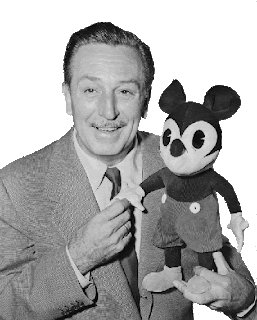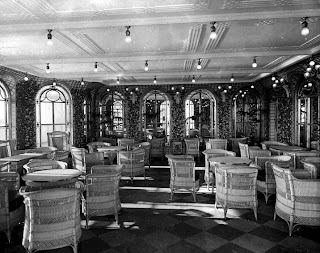
Disney as an ambulance driver during World War I.
Walt Disney was born to Elias Disney an Irish-Canadian, and his mother, Flora Call Disney, who was of German-American descent. Walt Disney's ancestors had emigrated from Gowran, County Kilkenny in Ireland. Arundel Elias Disney, great-grandfather of Walt Disney was born in Kilkenny, Ireland in 1801 and was a descendant of Hughes and his son Robert d'Isigny (France) who settled in England with William the Conquereor in 1066.
Walt Disney was born to Elias Disney an Irish-Canadian, and his mother, Flora Call Disney, who was of German-American descent. Walt Disney's ancestors had emigrated from Gowran, County Kilkenny in Ireland. Arundel Elias Disney, great-grandfather of Walt Disney was born in Kilkenny, Ireland in 1801 and was a descendant of Hughes and his son Robert d'Isigny (France) who settled in England with William the Conquereor in 1066.

Disney became the cartoonist for the school newspaper. His cartoons were very patriotic, focusing on World War I. Disney dropped out of high school at the age of sixteen to join the Army, but the army rejected him because he was underage.

Walt Disney and Mickey Mouse, which starred in the first sound and animated feature in 1928.
After losing the rights to Oswald, Disney felt the need to develop a new character to replace him. He based the character on a mouse he had adopted as a pet while working in a Kansas City studio. Ub Iwerks reworked on the sketches made by Disney so that it was easier to animate it. However, Mickey's voice and personality was provided by Disney. As many of the old animators have commented, "Ub designed Mickey's physical appearance, but Walt gave him his soul."

WaltDisneyMedal

Walt Disney appears relaxed as he films one of his Disneyland openings.
On a business trip to Chicago in the late-1940s, Disney drew sketches of his ideas for an amusement park where he envisioned his employees spending time with their children. He got his idea for a children's theme park after visiting Children's Fairyland in Oakland, California.

WaltDisneyMedal

Walt Disney appears relaxed as he films one of his Disneyland openings.
On a business trip to Chicago in the late-1940s, Disney drew sketches of his ideas for an amusement park where he envisioned his employees spending time with their children. He got his idea for a children's theme park after visiting Children's Fairyland in Oakland, California.

As the studio expanded and diversified into other media, Disney devoted less of his attention to the animation department, entrusting most of its operations to his key animators, whom he dubbed the Nine Old Men. During Disney's lifetime, the animation department created the successful Lady and the Tramp (in CinemaScope, 1955), One Hundred and One Dalmatians (1961), Sleeping Beauty (in Super Technirama 70mm, 1959) and The Sword in the Stone (1963).

Walt Disney Autopia

Walt Disney meets with Wernher von Braun.

By the early 1960s, the Disney empire was a major success, and Walt Disney Productions had established itself as the world's leading producer of family entertainment. Walt Disney was the Head of Pageantry for the 1960 Winter Olympics. After decades of pursuing, Disney finally procured the rights to P.L. Travers' books about a magical nanny. Mary Poppins, released in 1964, was the most successful Disney film of the 1960s and featured a memorable song score written by Disney favorites, the Sherman Brothers.

Plaque at the entrance that embodies the intended spirit of Disneyland by Walt Disney to leave reality and enter fantasy

A theatrical poster for the Alice Comedies short Alice in the Jungle (1925).

Production on the short cartoons had kept pace until 1956, when Disney shut down the shorts division. Special shorts projects would continue to be made for the rest of the studio's duration on an irregular basis. These productions were all distributed by Disney's new subsidiary, Buena Vista Distribution, which had assumed all distribution duties for Disney films from RKO by 1955. Disneyland, one of the world's first theme parks, finally opened on July 17, 1955, and was immediately successful.

An aerial view of Disneyland in 1956. The entire route of the Disneyland Railroad is clearly visible as it encircles the park.

Disney introduces his popular creations Mickey, Minnie Mouse and Pluto to Hansel and Gretel (Dorothy Rodin and Virginia Murray).

Disney seems to be enjoying himself as he introduces viewers to his new TV series, Zorro.

(Left to right) Robert B. Sherman, Richard M. Sherman and Walt Disney sing there's a Great Big Beautiful Tomorrow (1964)

(Left to right) Robert B. Sherman, Richard M. Sherman and Walt Disney sing there's a Great Big Beautiful Tomorrow (1964)

Disney World was to include a larger, more elaborate version of Disneyland which was to be called the Magic Kingdom. It would also feature a number of golf courses and resort hotels. The heart of Disney World, however, was to be the Experimental Prototype City (or Community) of Tomorrow, or EPCOT short.

Disneyland, one of the world's first theme parks, finally opened on July 17, 1955, and was immediately successful. Visitors from around the world came to visit Disneyland, which contained attractions based upon a number of successful Disney properties and films. After 1955, the show, Disneyland came to be known as Walt Disney Presents.

1968 US postage stamp

Disney's involvement in Disney World ended in late 1966; after many years of chain smoking cigarettes, he was diagnosed with lung cancer. He was admitted to Providence St. Joseph Medical Center across the street from the Disney Studio, where his health began to deteriorate, causing him to suffer cardiac arrest.

















































